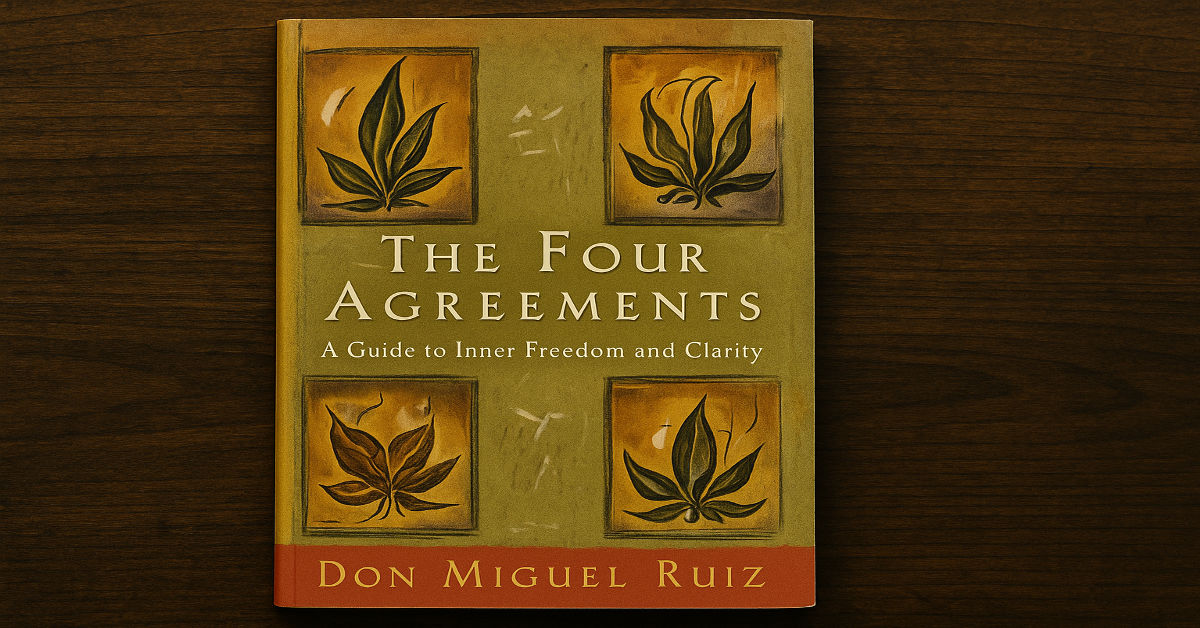Sometimes the most profound wisdom arrives not in complexity but in simplicity. That was my experience when I first opened The Four Agreements by Don Miguel Ruiz. What appeared to be a small, simple book turned out to be a treasure trove of transformative insights The Four Agreements Summary.
This summary explores each of the four core principles in the book and how they apply to personal growth, relationships, and emotional resilience.
Who Is Don Miguel Ruiz?
Don Miguel Ruiz is a Mexican author and spiritual teacher best known for bringing ancient Toltec wisdom into modern life. Drawing from native Mesoamerican teachings, he created a clear roadmap for personal freedom and emotional peace.
His work resonates with people across all walks of life, regardless of background or belief.
What Is The Four Agreements?
The Four Agreements is based on the idea that we’ve all been “domesticated” by societal norms, beliefs, and expectations. Ruiz argues that we adopt limiting rules early in life and live according to them without questioning their validity.
By adopting four empowering agreements with ourselves, we can break these invisible chains and live authentically.
Agreement One: Be Impeccable with Your Word
This means saying what you mean and meaning what you say. Being impeccable is not just about avoiding lies, but also about using words responsibly—especially toward yourself.
Words are powerful. They can build or destroy. They can affirm or limit. By using your voice with integrity, you create positive energy and reinforce your own truth.
How to Apply:
- Speak with honesty and clarity
- Avoid gossip and self-criticism
- Use affirmations to rewire negative patterns
Agreement Two: Don’t Take Anything Personally
What others say and do is a projection of their own reality. When you stop personalizing criticism or praise, you free yourself from emotional dependency on external validation.
This agreement is a shield against needless suffering. It helps reduce conflict, resentment, and insecurity.
How to Apply:
- Detach from external judgments
- Practice empathy instead of reaction
- Remember that everyone has their own lens
Agreement Three: Don’t Make Assumptions
Misunderstandings stem from assumptions. When you assume, you create imaginary scenarios and act on them as if they’re true. Ruiz emphasizes the power of asking questions and expressing what you want clearly.
This agreement cultivates transparency, improves communication, and deepens relationships.
How to Apply:
- Ask instead of guess
- Clarify your expectations
- Listen actively and patiently
Agreement Four: Always Do Your Best
Your best is not static. It changes depending on your energy, mindset, and life circumstances. This agreement is about giving your full effort without self-judgment.
When you do your best, you eliminate regret and guilt. You recognize your growth instead of punishing your imperfections.
How to Apply:
- Set small, consistent goals
- Acknowledge progress over perfection
- Be kind to yourself on hard days
Table: Summary of the Four Agreements
| Agreement | Core Message | Application Tip |
| Be Impeccable with Your Word | Speak with integrity; avoid self-sabotage | Use words to uplift and heal |
| Don’t Take Anything Personally | Nothing others do is because of you | Detach from praise or blame |
| Don’t Make Assumptions | Communicate clearly to avoid conflict | Ask questions before jumping to conclusions |
| Always Do Your Best | Your best varies—just show up and try | Celebrate effort, not just results |
Real-Life Application and Personal Impact
When I began applying these agreements, I noticed changes almost immediately. Speaking truthfully yet kindly transformed my conversations. Letting go of assumptions reduced unnecessary conflict. I began showing up with intention—not to be perfect, but to simply do my best.
Each agreement opened a door: to forgiveness, to understanding, and to deeper self-love.
Why These Agreements Still Matter Today
In today’s noisy digital world, misinformation, assumptions, and reactive emotions are everywhere. The Four Agreements cut through the clutter, offering timeless principles rooted in self-awareness and mindfulness.
They empower you to:
- Manage stress
- Build stronger relationships
- Cultivate mental and emotional resilience
Whether you’re navigating a tough job, social anxiety, or personal setbacks, these agreements serve as anchors.
Criticism and Alternative Views
While many praise The Four Agreements for its clarity and wisdom, some critics argue it oversimplifies complex psychological issues. Others feel that the language leans too heavily into spiritual jargon.
However, its core messages have universal relevance. The book doesn’t claim to replace therapy or religious belief—it simply offers a framework for living with awareness and purpose.
Conclusion
The Four Agreements Summary offers a timeless blueprint for conscious living. By integrating these simple yet profound principles, you can create a life grounded in truth, peace, and connection.
If you’re ready to stop surviving and start thriving, these The Four Agreements Summary are a good place to begin. Not every day will be perfect, but with these tools, every step can be meaningful.
Start today—choose one agreement and commit to practicing it. Small shifts lead to lasting transformation.
Frequently Asked Questions (FAQ)
What are The Four Agreements in short?
They are: Be impeccable with your word, don’t take anything personally, don’t make assumptions, and always do your best.
Who is the target audience of The Four Agreements?
Anyone seeking self-improvement, emotional healing, or spiritual growth can benefit from this book.
Is The Four Agreements religious?
No, the book is spiritual in tone but not tied to any one religion. It draws from ancient Toltec wisdom.
Can I use these principles in the workplace?
Absolutely. Practicing clear communication, empathy, and integrity is valuable in professional environments.
What’s the biggest challenge in living these agreements?
Consistency. It’s easy to fall back into old patterns, but awareness helps you course-correct.

